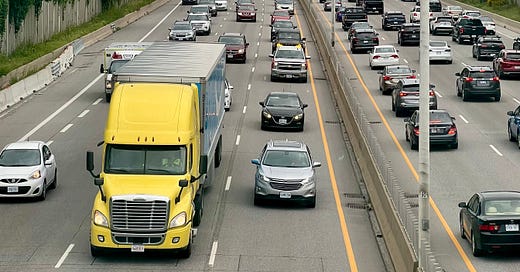How Will Ottawa Manage an Additional 50,000 Cars on our Roads Every Day?
The best solution to congestion is to provide real choice in how people move around the city.
Rush Hour Traffic is Already Bad Enough
The million people in Ottawa account for about 170,000 cars on the road each workday. (2021, StatCan)
The City is expected to grow by 400,000 people over 25 years. If those new residents move around the city the same way that current residents do, we can expect an extra 50,000 cars on our roads every workday.
Think of Highway 417. It’s already bumper to bumper in rush hour. Now imagine adding another 10,000 cars. If you hate your commute now …
The 3 Solutions Put Forward for Fixing Congestion
1. Expand the Roads
The most common response to congestion by politicians and traffic engineers is to build new roads and make existing ones wider.
But expanding the road network creates induced demand — as the road capacity grows, more people choose to travel by car. The open space on the road makes driving more attractive, and so more people decide to travel by car.
With road expansions, we see some relief for about 18 months. But as more people learn about the open road, more people use it. And it’s not long until an expanded 6-lane highway is just as congested as the previous 4-lane highway.
New York City first discovered induced demand in the 1930s, as documented by Robert Caro in The Power Broker. The more roads and bridges the City built, the more people decided to travel by car.
And we have been rediscovering induced demand ever since.
However …. the road engineering industry is dependent upon building more roads. And so, we’re reminded of the famous quote from Upton Sinclair:
“It is difficult to get a man to understand something, when his salary depends on his not understanding it.”
Which writer Andy Boenau of Urban Speakeasy has reinterpreted for us as:
“Road expansions only temporarily reduce traffic congestion, but professionals only temporarily remember expansions don’t work.”
Building or expanding roads is presented as the solution to congestion, even though people know deep down that it is a temporary solution at best. And that it can cost millions, if not billions, in construction costs.
2. Road Pricing
The second option for curbing congestion is to charge users to drive on roads. London introduced a congestion charge 20 years ago, which has reduced congestion by 30%. Singapore, Stockholm, Milan and other cities have had congestion charges for many years.
New York City is set to introduce a congestion charge this summer.
Whether it is congestion charging, low emission zones or increased parking charges, more and more cities around the world are looking at ways to get less people driving by increasing its price.
Before its introduction, a road pricing scheme will face tough opposition. But once established, the experience around the world has been for residents to quickly adapt and appreciate the reduction in congestion.
3. Viable Alternatives to Driving
The third option is to give people real options for getting around Ottawa. The reality now is that many people have no choice.
Transit is effectively broken. OC Transpo is less and less of a viable option — in terms of time, money or reliability — for anyone with access to a car. For people to have a choice in getting around town, they need a transit system that is frequent, reliable and affordable.
Active transportation infrastructure is insufficient. More bikes and pedestrians means less people in cars. But to get people cycling, the city needs a safe and complete bike network. Ottawa has a partial bike network, and being forced to navigate any level of unsafe streets is a deal breaker for many. Walking works for some neighbourhoods, but is impractical in many others.
Freedom to Choose
Let’s look at these 3 potential solutions.
Expanding the road network is very expensive, and ultimately doesn’t work.
Road pricing is effective, but politically very challenging.
Creating viable alternatives to driving is effective and affordable. It’s also something that we are already doing — just at a snail’s pace.
Since our Council is not prepared to do much of anything that challenges the status quo, option 2 is not going to happen any time soon. So it comes down to option 1 or option 3.
We can continue to force people into cars as our city grows by 40% over the next 25 years. We can increase our property taxes in order to spend billions on expanding roads. And all that time, traffic congestion will simply go from bad to worse.
Or we can give people the freedom to choose how they move around the city.
Get people out of cars, and give them the freedom to travel, whether that’s driving, taking transit, biking or walking. Right now, only drivers have that freedom.






This article's singular focus on transport and mobility neglects to consider the intrinsic link between transport and land use. Land use decisions that promote urban sprawl and suburban single use car-centric development will inevitably lead to greater demand for roadway capacity. Reliable and efficient transit is a significant part of the solution and needs to be supported by the right combinations of sustainable and walkable communities, TOD, POD (Pedestrian Oriented Development), rideshare programs, and alternative work arrangements.
Offering choices is a must to succeeding in not expanding road capacity. Besides scootering, biking and walking, affordable and efficient transit (including ride hailing) is the key policy lever.
Is anybody in OC Transpo or City Hall thinking in radical terms? If not, let's give them a hand.